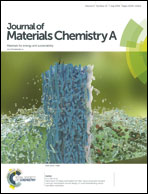A high-tap-density nanosphere-assembled microcluster to simultaneously enable high gravimetric, areal and volumetric capacities: a case study of TiO2 anode†
Abstract
Designing nanomaterial-based electrodes has emerged as a promising method to substantially improve the electrochemical performance of lithium ion batteries (LIBs). However, the practical use of nanotechnology in LIBs generally results in electrode materials with low tap densities, which leads to low areal and volumetric capacities as well as limited areal mass loading. A rational electrode design strategy should compensate for these inherent disadvantages while making full use of the merits of nanomaterials. Herein, taking TiO2 as an example, we elucidate the construction of an anode that takes into consideration the advantages of both nano- and microarchitectures. The obtained microcluster (0.9 μm in diameter) is a hierarchical ensemble of graphitic carbon-conformal hollow TiO2 nanospheres (50 nm in diameter) with {001}-rich facets, showing a tap density of 1.7 g cm−3 (15 times that of Degussa P25 TiO2 nanoparticles) and, thus, a large electrode density of 5.4 g cm−3. At a current density of 1675 mA g−1, an anode with a mass loading of 15.6 mg cm−2 not only manifests a stable areal capacity of 3.2 mA h cm−2 and gravimetric capacity of 160 mA h g−1 over 1000 cycles, but also delivers an exceptional volumetric capacity of 859 mA h cm−3, which is 1.6 and 2.5 times those of state-of-the-art graphite and TiO2 anodes, respectively. Inheriting advantages from both nano- and micro-scale structures is crucial to simultaneously achieve high gravimetric, areal and volumetric capacities. This work addresses typical inherent issues of nanomaterial electrodes, offering an important step forward towards practical applications.



 Please wait while we load your content...
Please wait while we load your content...